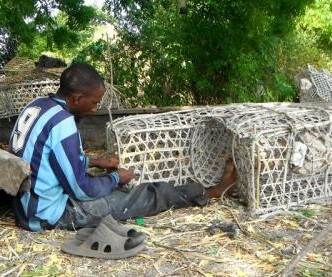Trap gaps catch more and less
 It may not work for mice, but the Wildlife Conservation Society and Kenyan marine authorities have built a better fish trap.
It may not work for mice, but the Wildlife Conservation Society and Kenyan marine authorities have built a better fish trap.
A development will allow fisherfolk to keep the fish they are looking for while using escape gaps to reduce bycatch.
The design developed by the WCS and the Kenyan Marine and Fisheries Research Institute is based on traditional African fish traps and will catch larger fish, allow more undersized and non-target fish to escape, increase profits, and - most importantly - minimize the impact of fishing on coastal reef systems.
Experimental studies on design modifications have found that with a little bit of planning and tricky stitching, it is possible to pull more benefits from the ancient fishing style, without increasing accidental damage.
“One of the great challenges in coastal fisheries is how to reduce the levels of bycatch for reef systems where these species play important ecological roles,” said Dr. Tim McClanahan, co-author of the study and head of WCS's coral reef research and conservation program.
“Our modified traps have made a statistically measurable difference in minimizing bycatch for African basket traps. Such innovations can make a big difference in maintaining the ecology of vital coastal resources.”
Tests of escape gap designs with experienced fishers in specific sites led to an average 31 per cent longer and 55 percent heavier catch than fish in traps without gaps.
“These new escape gaps are a game changer for Kenya's coastal fisheries,” said Dr. Caleb McClennen, Director of WCS's Marine Programs.
“By reducing bycatch, the new basket traps increase fish size, economic return, while limiting the bycatch that can harm entire reef systems. These innovations can also be exported to other coastal fisheries for the benefit of entire regions.”
A paper on the experimental study appears in the current edition of Fisheries Research.







 Print
Print